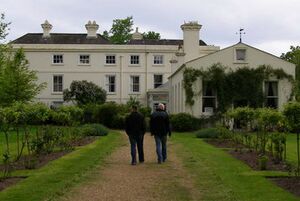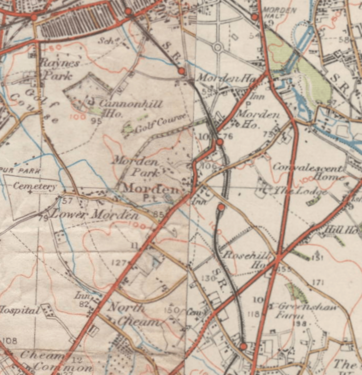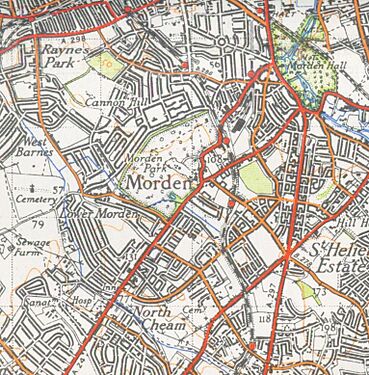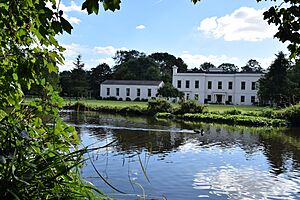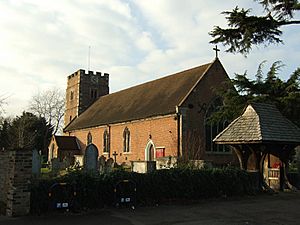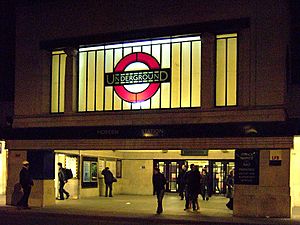Morden facts for kids
Quick facts for kids Morden |
|
|---|---|
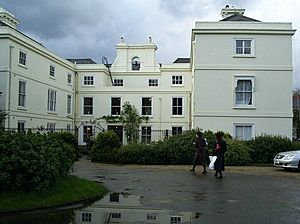 Morden Hall |
|
| Population | 48,233 (2011) |
| OS grid reference | TQ255685 |
| London borough | |
| Ceremonial county | Greater London |
| Region | |
| Country | England |
| Sovereign state | United Kingdom |
| Post town | Morden |
| Postcode district | SM4 |
| Dialling code | 020 |
| Police | Metropolitan |
| Fire | London |
| Ambulance | London |
| EU Parliament | London |
| UK Parliament |
|
| London Assembly |
|
Morden is a town and area in south London, England. It is part of the London Borough of Merton. Morden is about 8 miles (13 km) southwest of Charing Cross, a central point in London. Before 1965, Morden was part of the county of Surrey.
In 2011, Morden had a population of 48,233 people. This number includes areas like Cannon Hill, Lower Morden, Merton Park, Ravensbury, and St Helier.
Morden Hall Park, a beautiful park run by the National Trust, is a main feature of the area. It sits along the River Wandle right next to the town centre.
Contents
What Does Morden Mean?
The name Morden might come from old British words. Mawr means "great" or "large," and Dun means "fort." So, it could mean "Great Fort." Another idea is that it means "The Town on the Moor," which is a type of open, grassy land.
Morden's Past
Early History of Morden
People have lived in the Morden area since the Iron Age. This was a time when Celtic tribes lived around places like Wimbledon. The first big change in Morden was when the Roman road called Stane Street was built. This road connected Chichester to London.
The Roman road followed the path of today's A24 (London Road). It went up Stonecot Hill, through Morden Park, and past St Lawrence's Church. Then it went down the hill towards the town centre, passing near the Underground station. Small Roman items, like coins and pottery, have been found here. But there is no sign that a Roman town or village was ever built in Morden.
In 1015, a prince named Ethelstan left "land at Mordune" to an abbey. This land later became the site of the first Saxon church, St Lawrence. In 1086, the Domesday Book recorded Morden as Mordone. It was owned by Westminster Abbey. The area had a mill, ploughs, and 14 people living there.
The Garth Family's Influence
Morden remained abbey property until King Henry VIII closed the monasteries. Then, the land was sold to Sir Richard Garth in 1547. The Garth family owned the land and were important in Morden for the next 400 years. They lived at Morden Hall Park. The manor was sold by another Sir Richard Garth in 1872.
The Garth family's importance is still seen today. Garth Road in Lower Morden is named after them. The two lions on the London Borough of Merton's official coat-of-arms come from the Garth family's own coat-of-arms.
Morden in the 1800s
| 19th century | 20th century | ||
|---|---|---|---|
| 1801 | 512 | 1901 | 960 |
| 1811 | 549 | 1911 | 1,202 |
| 1821 | 638 | 1921 | 1,355 |
| 1831 | 655 | 1931 | 12,618 |
| 1841 | 685 | 1941 | war |
| 1851 | 628 | 1951 | 35,417 |
| 1861 | 654 | 1961 | 68,011 |
| 1871 | 787 | 1971 | 62,872 |
| 1881 | 694 | 1981 | 61,108 |
| 1891 | 763 | 1991 | n/a |
Even though nearby Wimbledon grew quickly with new railways, Morden stayed a quiet farming area throughout the 1800s. Wimbledon's population jumped from 1,591 in 1801 to 41,652 in 1901. But Morden's population only grew from 512 to 960 in the same time.
In 1871, Morden parish was about 1,475 acres (6 square km). The small village was around St Lawrence's church. This was on the main road from London to Epsom. About half a mile west of the village was the small area of Lower Morden.
Near the church was the George Inn, an old coaching inn from the 1600s. There was also the Morden Park estate and a school. The Crown Inn was another main pub, located northeast of the village. The rest of what is now Morden's town centre was just fields.
In the late 1800s, farming was still the main job. But there were some factories along the River Wandle. Watermills ground tobacco into snuff, and a varnish factory was near where Poplar Primary School is now. By 1898, the varnish factory was gone. A brickworks was built where Mostyn Gardens is today.
Morden in the 1900s
In 1894, Morden became part of the Croydon Rural District in Surrey. For the first 20 years of the 1900s, the village changed little. Farming was still the main activity. However, the area of Merton to the north grew. So, Merton became its own urban district in 1907. Morden joined Merton in 1913, forming the Merton and Morden Urban District.
Big changes came in 1926 when Morden Underground station opened. It was the end of a new extension of the City & South London Railway. This line is now part of the London Underground's Northern line. This new, fast route to Central London made Morden a popular place for people to live.
A garage was built near the new tube station. In 1932, Morden Cinema was built next to it. Around the station, a new shopping area quickly grew. Shops appeared along London Road and Crown Lane. This included a rebuilt Crown pub and a large department store.
Away from the new town centre, the old country roads were made wider. Fields were quickly turned into building plots for new homes. More transport improvements came with a new railway line. This line went from Wimbledon to Sutton. It had stations at South Merton and Morden South. This new line opened between 1930 and 1933.
Because of these new train and bus links, Morden's population grew very fast. It went from 1,355 people in 1921 to 12,618 in 1931. In the next 15 years, the population kept growing. Most of the area was covered with new suburban houses.
One of the main housing projects in the 1930s was the St. Helier estate. The London County Council (LCC) built it for workers from central London. It was named after Lady St. Helier, an LCC leader. This estate was the largest local authority housing project in South London at the time. Its road names are in alphabetical order. They are all named after religious places, showing that Westminster Abbey used to own the land.
In 1943, the local council got its own coat-of-arms. It included lions from the Garth family and a pattern from Merton Priory. The motto, "In Libertate Vis", means "Our Strength is our Freedom". In 1965, the Merton and Morden Urban District Council was closed. Its area joined with Wimbledon and Mitcham to form the current London Borough of Merton.
Morden Today
Even with London's growth, some of Morden's old rural feel remains. Several grand old buildings are still standing, especially in Morden's parks. The area has many parks and green spaces. Many of these were once large country estates. The 125-acre Morden Hall Park is very special. It is run by the National Trust. Its main entrance is very close to Morden Underground Station.
The biggest building in the town centre is Crown House. It was built in the 1960s and is 14 storeys tall. It has a curved front and a "chessboard" look with light and dark parts. The building includes The Crown public house. It is also home to Merton Civic Centre and a large library.
Around the same time, Morden Underground Station, which was originally one storey, had three floors of offices added above it. Another office building with a large supermarket (now a Sainsbury's) was built in the 1980s. The old cinema and garage were taken down years ago and replaced with shops.
Famous Places in Morden
Morden has several interesting buildings and parks:
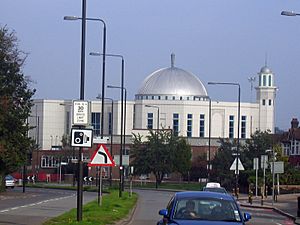
- The Bait'ul Futuh Mosque is one of the largest mosques in Western Europe. It was built by the Ahmadiyya Muslim Community. Finished in 2003, it cost about £5.5 million. The mosque covers 5.2 acres (21,000 square meters) and can hold up to 10,000 worshippers. It is near Morden South railway station and Morden Underground station.
- Morden Hall Park is a key part of Morden. It has large, old buildings within its grounds. It is a National Trust park along the River Wandle. It's close to the town centre and Morden Underground station. The park has over 50 hectares (125 acres) of land. The River Wandle flows through it with many bridges. The estate has historic buildings like Morden Hall itself, Morden Cottage, an old Snuff Mill, and old farm buildings. Some of these are now a garden centre and a city farm. The rose garden has more than 2,000 roses. The land was originally owned by Westminster Abbey. Morden Hall itself dates back to the 1770s. It has different natural areas, including parkland, meadows, and marshland.
- Morden Park is another park with an important old building. The park includes land that was once part of the Morden Park House estate. Morden Park House is a small country house from the 1700s. It was built in the 1770s for a merchant named John Ewart. It has beautiful gardens.
- St Lawrence Church, Morden is the local Church of England parish church. The building is a Grade I listed building, which means it's very important historically. It's on London Road, at the highest point of Morden. It overlooks Morden Park. The current church was built in the 1630s. It replaced an older wooden church from the Saxon period.
- Morden Baptist Church opened in 1935. It replaced an older building from 1885. The church's main entrance faces Crown Lane. In 1990, the church was greatly expanded to provide better facilities.
Sports and Fun
Morden has a football club called Tooting & Mitcham United F.C.. They play their games at Imperial Fields.
Getting Around Morden
The closest tube station is:
- Morden Underground station
The closest railway stations and tramlink stops are:
- Morden South railway station
- Morden Road tram stop
- South Merton railway station
- St. Helier railway station
- Phipps Bridge tram stop
- Belgrave Walk tram stop
- Mitcham tram stop
Local day and night buses that serve Morden include:
- 80 (Belmont High Down & Downview – Hackbridge Reynolds Close)
- 93 (Putney Bridge – North Cheam) (24 Hour)
- 118 (Morden Station – Brixton)
- 154 (Morden Station – West Croydon Bus Station)
- 157 (Morden Station – Crystal Palace)
- 163 (Wimbledon Station – Morden Station)
- 164 (Wimbledon Station – Sutton Station)
- 201 (Morden – Herne Hill)
- 293 (Morden Station – Epsom General Hospital)
- 413 (Morden Tube Station – Sutton Bus Garage)
- 470 (Epsom Town Centre – Colliers Wood Tube Station)
- K5 (Morden – Ham)
- N155 (Morden Station – Aldwych)
Famous People from Morden
Some notable people connected to Morden include:
- Mariot Arbuthnot – A commander in the Royal Navy during the American War of Independence.
- Joseph Bazalgette – An engineer who designed London's sewer system. He lived in Morden for a few years in the 1870s.
- Richard Garth – A Lord of the Manor, important advisor, and Chief Justice of Bengal.
- Alexander Maconochie – He helped start the Royal Geographical Society and worked to improve prisons.
- Good Shoes – An indie music band. Their first album included a song called "Morden".
- Sampha – A singer-songwriter known for working with artists like SBTRKT, Jessie Ware, and Drake.
Nearby Places
- Colliers Wood
- Hackbridge
- Merton Park
- Mitcham
- Lower Morden
- Motspur Park
- Raynes Park
- St. Helier
- South Wimbledon
- Sutton
- Sutton Common
- Wimbledon
- Worcester Park
Images for kids
See also
 In Spanish: Morden para niños
In Spanish: Morden para niños



